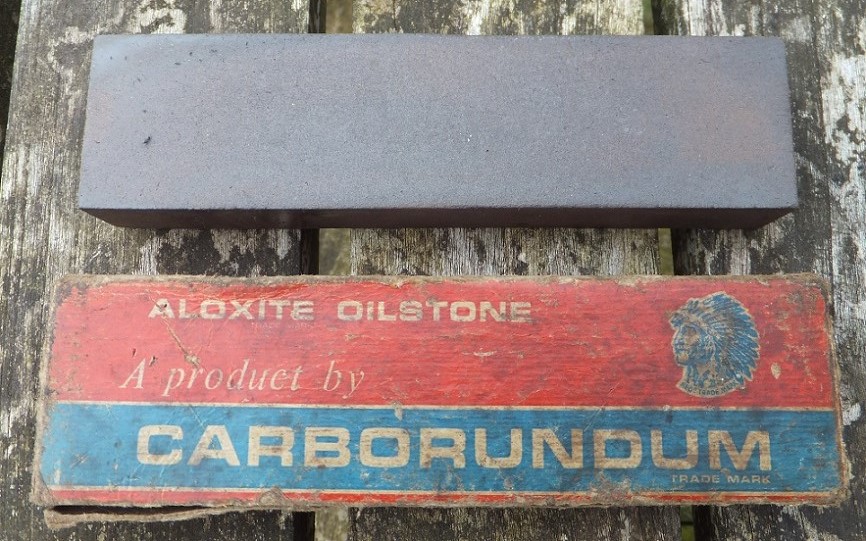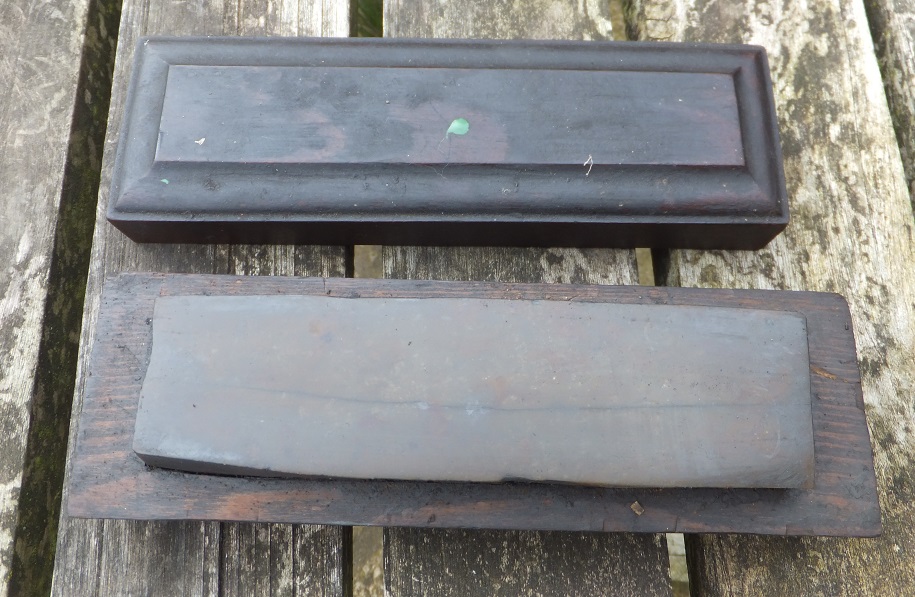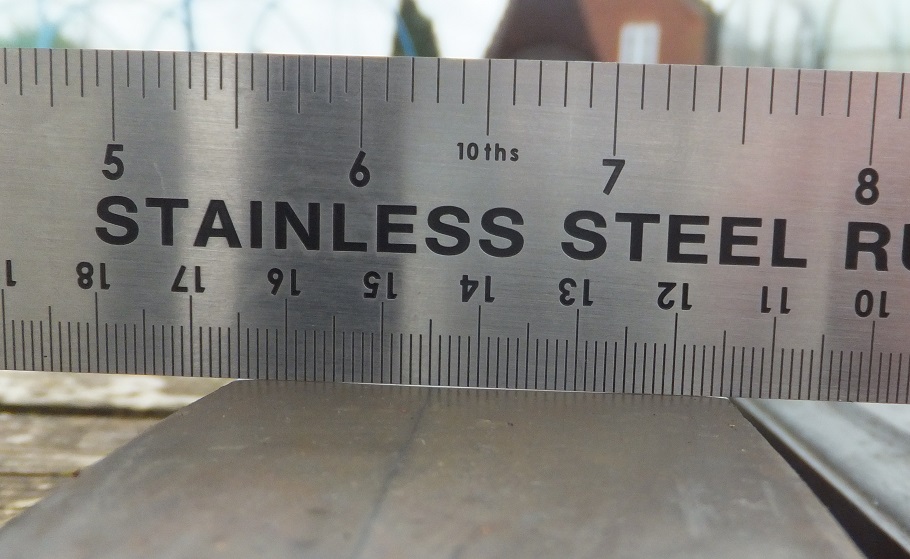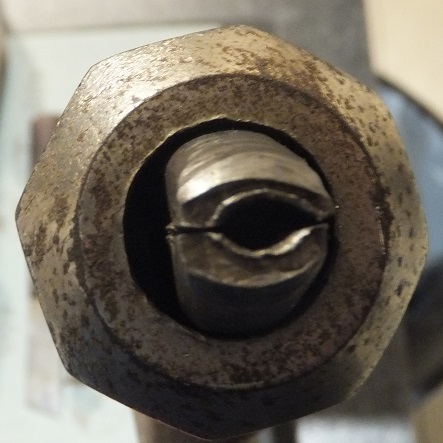You are using an out of date browser. It may not display this or other websites correctly.
You should upgrade or use an alternative browser.
You should upgrade or use an alternative browser.
Some beginner questions
- Thread starter mrbadexample
- Start date

Help Support UKworkshop.co.uk:
This site may earn a commission from merchant affiliate
links, including eBay, Amazon, and others.
mrbadexample
Established Member
I've got a couple of oilstones - does anyone have any idea what sort of grit level this is likely to be?


What does it mean by 'combination' stone? As far as I can see there's no division in the middle that would indicate different grades per side so I think it's all the same. From what I can make out, it seems to be a fairly decent one.


What does it mean by 'combination' stone? As far as I can see there's no division in the middle that would indicate different grades per side so I think it's all the same. From what I can make out, it seems to be a fairly decent one.
Attachments
mrbadexample
Established Member
I've also got this one that someone's carefully made a nice box for. It feels completely smooth to the touch so must be a high grit level. It's not flat, unfortunately.




I assume it must be a decent stone for someone to take the trouble to make the box for it, and it's seen a lot of use. Can it (does it need to) be restored?




I assume it must be a decent stone for someone to take the trouble to make the box for it, and it's seen a lot of use. Can it (does it need to) be restored?
Attachments
mrbadexample
Established Member
I've got an old brace and a load of bits of various descriptions. The brace is no use at the moment as the jaws are knackered.
Is there anywhere that supplies replacement jaws please? They're the alligator type with the captive spring.
Is there anywhere that supplies replacement jaws please? They're the alligator type with the captive spring.
Cheshirechappie
Established Member
Picture 1 is a group of cutting irons for a wooden plough plane - thing for making grooves. You seem to have a fair range of sizes.
Wooden ploughs were sometimes sold with a set of eight irons, numbered 1 to 8. They started at 1/8" (nominal - they were ground by hand and rarely dead-nuts to size, but usually pretty close) which was a number 1 iron, and went up in 1/16" increments, so 3/16" was a 2, 1/4" was a 3, and so on up to 9/16" which was number 8. The number is usually stamped at the top end.
If you look very carefully at the sharp end, you may see a slight difference in colour between the steel on the top face of the iron, and the wrought iron that makes up the bulk of each cutter - so-called 'lamination'. That was quite common on older edge tools - forge welding a small piece of expensive tool steel to make the cutting edge to a larger chunk of much cheaper (and easier to forge) wrought iron for the bulk.
The biggest problem when sourcing a wooden plough is not finding the plane - they're quite common and often not very expensive - it's finding a set of cutting irons. Consequently, you've had the big problem solved already. All you need now is a decent plough plane!
Wooden ploughs were sometimes sold with a set of eight irons, numbered 1 to 8. They started at 1/8" (nominal - they were ground by hand and rarely dead-nuts to size, but usually pretty close) which was a number 1 iron, and went up in 1/16" increments, so 3/16" was a 2, 1/4" was a 3, and so on up to 9/16" which was number 8. The number is usually stamped at the top end.
If you look very carefully at the sharp end, you may see a slight difference in colour between the steel on the top face of the iron, and the wrought iron that makes up the bulk of each cutter - so-called 'lamination'. That was quite common on older edge tools - forge welding a small piece of expensive tool steel to make the cutting edge to a larger chunk of much cheaper (and easier to forge) wrought iron for the bulk.
The biggest problem when sourcing a wooden plough is not finding the plane - they're quite common and often not very expensive - it's finding a set of cutting irons. Consequently, you've had the big problem solved already. All you need now is a decent plough plane!
mrbadexample":5m2kkday said:I've got a couple of oilstones - does anyone have any idea what sort of grit level this is likely to be?
What does it mean by 'combination' stone? As far as I can see there's no division in the middle that would indicate different grades per side so I think it's all the same. From what I can make out, it seems to be a fairly decent one.
I think your stone is probably better than the one that was in the box. So possibly a fine man made oilstone.

£19.99
Respirator Mask,Safety Dust Face Cover,Dust Face Cover Paint Face Cover,Gas Mask With Filter,For Paint,Dust And Formaldehyde,Sanding,Polishing,Spraying And Other Work
ShenZHEN CIRY MINGYANG LITIAN ELECTRONIC ECOMMERCE

£16.59
£25.00
Woodworking Joinery by Hand: Innovative Techniques Using Japanese Saws and Jigs
Amazon.co.uk

£234.08
£360.17
Trend Portable Benchtop Router Table with Robust Construction for Workshop & Site Use, 240V, CRT/MK3
Amazon.co.uk

£24.99
Facemoon Reusable Masks,Safety Masks,Dual Filter Masks, Paint, Dust, Epoxy Resin, Construction, Welding, Sanding, Woodworking, Chemical Reusable Gas Masks
ShenZHEN CIRY MINGYANG LITIAN ELECTRONIC ECOMMERCE

£12.50 (£1.25 / count)
£14.45 (£1.44 / count)
JSP M632 FFP3moulded Disposable Dustmask (Box of 10) One Size suitable for Construction, DIY, Industrial, Sanding, dust protection 99 Percent particle filtration Conforms and Complies to EN 149
Amazon.co.uk
mrbadexample":13ikqdqd said:I've also got this one that someone's carefully made a nice box for. It feels completely smooth to the touch so must be a high grit level. It's not flat, unfortunately.
I assume it must be a decent stone for someone to take the trouble to make the box for it, and it's seen a lot of use. Can it (does it need to) be restored?
I agree with your assumption. It's a natural stone, not a man made one.
You could wipe the dirt off the box, but remember that the stone was as it currently is when its former owner last used it. You are a beginner, he probably wasn't.
mrbadexample":2tfitdfn said:I've got an old brace and a load of bits of various descriptions. The brace is no use at the moment as the jaws are knackered.
Is there anywhere that supplies replacement jaws please? They're the alligator type with the captive spring.
Not that I know of. But finding a better brace is easier than finding good bits in useful sizes.
Cheshirechappie
Established Member
Pictures 2 and 3 are a pair of oilstones. The Carborundum Aloxite is a coarse/fine-ish (you'll feel which side is which if you rub a finger over it), the one in the wooden box looks like a natural stone, and if it feels smooth, it's for a final polish to refine an edge to that next level of sharpness.
There are some real sharpening stone geeks about, and no doubt one will be along shortly with chapter and verse. I'll just say that with a bit of a clean-up, those two stones used with some thin oil (3-in-1, baby oil or mineral oil, which are all pretty much the same thing) you have everything you need to hone and polish straight-edged tools in those two stones. Add a grinder of some sort, and you're all set!
There are some real sharpening stone geeks about, and no doubt one will be along shortly with chapter and verse. I'll just say that with a bit of a clean-up, those two stones used with some thin oil (3-in-1, baby oil or mineral oil, which are all pretty much the same thing) you have everything you need to hone and polish straight-edged tools in those two stones. Add a grinder of some sort, and you're all set!
The stone looks like a very fine washita type stone from the united states, but it's hard to tell for sure. They all feel really smooth when they're loaded.
The rest of the stuff that you have is yard sale goods. the irons are interesting, but their tapers will all be different and that makes them not particularly useful for someone wanting to stuff them into a plow plane.
The stone has the potential to be a dandy stone for actual use (the natural one), but not to be confused with lots of economic value (perhaps 30 - 40 pounds). Worth your while to have, though.
The rest of the stuff that you have is yard sale goods. the irons are interesting, but their tapers will all be different and that makes them not particularly useful for someone wanting to stuff them into a plow plane.
The stone has the potential to be a dandy stone for actual use (the natural one), but not to be confused with lots of economic value (perhaps 30 - 40 pounds). Worth your while to have, though.
mrbadexample
Established Member
AndyT":274getdq said:I think your stone is probably better than the one that was in the box. So possibly a fine man made oilstone.
Not the original half-box? :lol:
How should I store it? Presumably left partly-exposed in half a box isn't ideal.
I have seen combo stones where the division is nearly impossible to see, although generally you can see at least some differentiation (in colour if not in grit size, sometimes the two sides are not that far apart in grit number).mrbadexample":639ju7pc said:What does it mean by 'combination' stone? As far as I can see there's no division in the middle that would indicate different grades per side so I think it's all the same.
If the stone isn't what the box indicates you're never going to know for sure what it is, so for the potential user it's simply a case of trying it and seeing how it works.
Aloxite was Carborundum's equivalent of the India stones from Norton by the way. The original Carborundum stones were the equivalent of Norton's Crystolon.
Wrap it in newspaper for now. Or put it in a ziplock back if you like.mrbadexample":639ju7pc said:How should I store it? Presumably left partly-exposed in half a box isn't ideal.
Very nice box! Could do with a good clean but that's a better-than-average example.mrbadexample":639ju7pc said:I've also got this one that someone's carefully made a nice box for. It feels completely smooth to the touch so must be a high grit level. It's not flat, unfortunately.
Thorny issue I'm afraid, be prepared.mrbadexample":639ju7pc said:Can it (does it need to) be restored?
Can it? Yes. Does it need to be? That's a depends.
What the stone will be used for informs what should be done to it with some people not minding dished stones, although the nature and amount of the dishing is important. Personally I think it's useless as an anything-and-everything hone as it is and needs to be flattened. (Cue tons of pointless circular argument if a certain party sees this thread.)
But the first thing you should do is check the underside – if you can get it out of the case! – to see if this is already flat. If so you can just use that side.
If you go ahead with flattening this process will clean the surface while you're at it, although many prefer to clean their stones in advance of any surfacing work so they can get a good look at the natural features.
This may sound bonkers but the best place to source replacment jaws may be inside the chuck of another brace. And in the UK this doesn't mean you have to overpay for them!mrbadexample":639ju7pc said:Is there anywhere that supplies replacement jaws please? They're the alligator type with the captive spring.
Of course it could be the case that you might as well use the other brace if you've gotten it, unless you deliberately bought a basket case that still had good jaws. This isn't unheard of as they can be protected by grease while the bare exterior decays and decays over many years; I've pulled nearly pristine jaws from braces that were absolutely solid with rust!
How bad are the existing jaws?
mrbadexample
Established Member
ED65":33jm14z5 said:Very nice box! Could do with a good clean but that's a better-than-average example.
It is and it does - can't pick it up without getting filthy. I wasn't planning on doing anything other than making what I've got useable where possible, so am not looking to do anything other than clean it - BLO and steel wool? :?:
ED65":33jm14z5 said:But the first thing you should do is check the underside – if you can get it out of the case! – to see if this is already flat. If so you can just use that side.
Hmmm...it was glued in once, rough side down, apparently. :lol:

I've been playing with the other one to sharpen some chisels and plane blades. Considering I don't know what I'm doing, the Aloxite (or whatever it is) seems to be fairly user friendly. But how can I hone a plane iron on a wonky stone? Or a chisel, for that matter? :shock:
ED65":33jm14z5 said:How bad are the existing jaws?
Shot.

Attachments
mrbadexample
Established Member
Cheshirechappie":2m273avs said:I'll just say that with a bit of a clean-up, those two stones used with some thin oil (3-in-1, baby oil or mineral oil, which are all pretty much the same thing) you have everything you need to hone and polish straight-edged tools in those two stones. Add a grinder of some sort, and you're all set!
That's what I was hoping for - enough to do what I need without spending owt. I have a bench grinder. Ex-boot fair, guardless, probably lethal. :roll:
Along with these oddments I've got a few firmer chisels, a few bevel-edged chisels, a couple of heavy mortise chisels, some gouges of various sizes and a couple of saws. Most appear to have been abused a little bit as a minimum. They have lumps out of handles and edges. What I'm looking to do is to put things back to a decent working condition but not much more than that. Cleaned, sharpened, problems addressed but with most of the original character remaining.
I can't see me getting much use out of the plough plane irons.
Older irregular stones were often bedded so that they'd sit still and firmly in their honing box.
Once stones were cut in regular shapes one after the other, they could put them in manufactured boxes (or you could make a flat-bottomed box) and not have to do that.
From what I've seen, the users didn't spare the rod when it came to gluing them in.
Once stones were cut in regular shapes one after the other, they could put them in manufactured boxes (or you could make a flat-bottomed box) and not have to do that.
From what I've seen, the users didn't spare the rod when it came to gluing them in.
Sometimes some advice isn't the best advice. It was normal to use putty or plaster to fit a stone in a box.
I was clearly being too subtle when I said it got the shape it has because the last owner used it. Not by using it and then attacking it with an angle grinder to stop it being flat.
I was clearly being too subtle when I said it got the shape it has because the last owner used it. Not by using it and then attacking it with an angle grinder to stop it being flat.
mrbadexample
Established Member
AndyT":1fll1hkl said:I was clearly being too subtle when I said it got the shape it has because the last owner used it.
No, I got that. And you said that I'm a beginner and the last owner probably wasn't.
That's exactly the point really, I'm a beginner so I'd be more comfortable with a flat one.
I'd be happy to try and hone a gouge on it, but a plane iron? A 1" chisel? I don't know how I'd do that. :?
mrbadexample
Established Member
Bm101":fco3cob7 said:Can't offer advice but don't bin the plough irons whatever you do. Sell them. Even if you give them away. Just don't bin them.
:shock: I throw nothing. One day I might need them. Or someone else might need them. Plus there are always other uses - strikes me as they'd be ideal for something like this.
I'd normally start cleaning with soapy water but I wouldn't risk warping a box like this so I think white spirit and old toothbrush to begin with, followed by more white spirit and regular changes of kitchen paper. When it's as clean as it'll get then BLO and steel wool by all means.mrbadexample":3vsxscmp said:BLO and steel wool? :?:
Ah well, worth a shot! So flattening the top seems to be the way to go.mrbadexample":3vsxscmp said:Hmmm...it was glued in once, rough side down, apparently. :lol:
That does look bad but remember they were that way the last time it was used. Something else to bear in mind is that the pyramidal block on the end of brace bits is part of what the jaws grip to, internally where we can't see.mrbadexample":3vsxscmp said:Shot.ED65":3vsxscmp said:How bad are the existing jaws?
I've used braces with jaws that look similarly worn and they've held the bits from all right to perfectly well.
My thinking exactly. I was going to link to a previous post of mine but it's in a verrrry long and contentious thread that you shouldn't get distracted by so I'll just quote it here.mrbadexample":3vsxscmp said:I'd be happy to try and hone a gouge on it, but a plane iron? A 1" chisel? I don't know how I'd do that. :?
I strongly strongly strongly advise you to start with flat honing surfaces, whatever they are, and keep them that way if they do require maintenance. You can use a dished stone later on when you know what you're doing but starting with one is a recipe for disaster. It's especially bad if you use multiple stones and only one is dished, and even worse if all are dished but with different curvatures! This is something that can see you chasing your tail for hours, plus can contribute to struggling with getting consistently good edges for years. And I do mean these times literally; I've spoken to numerous people online and in person who took up woodworking long before I did and still can't get edges they're happy with every time. And that's without the added complication of a curved honing surface!
Flat stones (any flat honing surface) are so much more versatile I can't emphasise it enough. You can hone to and fro or side to side, along the stong as well as across, anywhere on the surface, as mood, space or circumstances dictate and always get the same results. You cannot do this on a stone dished in one direction much less two.
Only on a flat surface can you do the bevel and the back, on any chisel down to the narrowest available up to the widest plane irons made, as well as hone a razor blade, a marking knife or an awl if need be, again in any direction anywhere on the surface with equal ease. Flat honing surfaces handle flat bevels, convex bevels or ground concave bevels; a dished stone can really only do one of those and not even as well.
Similar threads
- Replies
- 2
- Views
- 486





































